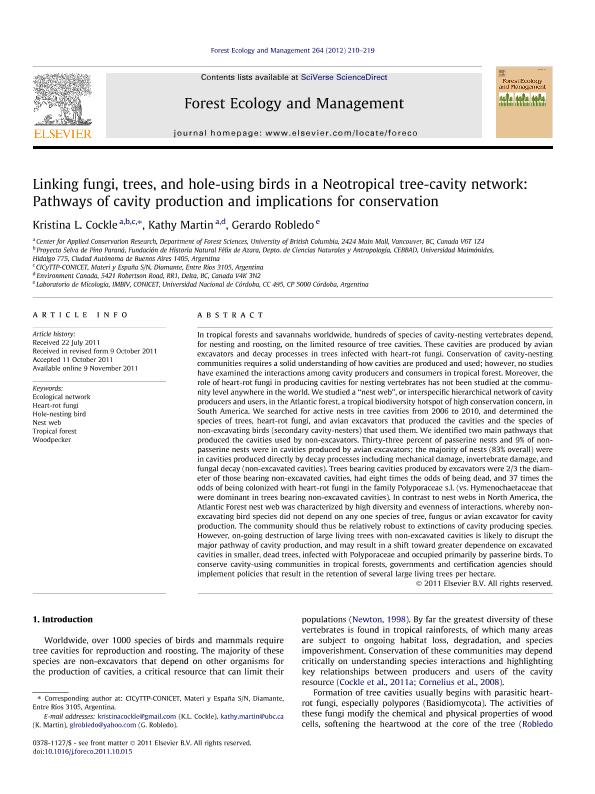Mostrar el registro sencillo del ítem
dc.contributor.author
Cockle, Kristina Louise

dc.contributor.author
Martin, Kathy
dc.contributor.author
Robledo, Gerardo Lucio

dc.date.available
2018-09-26T18:02:18Z
dc.date.issued
2012-01
dc.identifier.citation
Cockle, Kristina Louise; Martin, Kathy; Robledo, Gerardo Lucio; Linking fungi, trees, and hole-using birds in a Neotropical tree-cavity network: Pathways of cavity production and implications for conservation; Elsevier Science; Forest Ecology and Management; 264; 1-2012; 210-219
dc.identifier.issn
0378-1127
dc.identifier.uri
http://hdl.handle.net/11336/60922
dc.description.abstract
In tropical forests and savannahs worldwide, hundreds of species of cavity-nesting vertebrates depend, for nesting and roosting, on the limited resource of tree cavities. These cavities are produced by avian excavators and decay processes in trees infected with heart-rot fungi. Conservation of cavity-nesting communities requires a solid understanding of how cavities are produced and used; however, no studies have examined the interactions among cavity producers and consumers in tropical forest. Moreover, the role of heart-rot fungi in producing cavities for nesting vertebrates has not been studied at the community level anywhere in the world. We studied a " nest web" , or interspecific hierarchical network of cavity producers and users, in the Atlantic forest, a tropical biodiversity hotspot of high conservation concern, in South America. We searched for active nests in tree cavities from 2006 to 2010, and determined the species of trees, heart-rot fungi, and avian excavators that produced the cavities and the species of non-excavating birds (secondary cavity-nesters) that used them. We identified two main pathways that produced the cavities used by non-excavators. Thirty-three percent of passerine nests and 9% of non-passerine nests were in cavities produced by avian excavators; the majority of nests (83% overall) were in cavities produced directly by decay processes including mechanical damage, invertebrate damage, and fungal decay (non-excavated cavities). Trees bearing cavities produced by excavators were 2/3 the diameter of those bearing non-excavated cavities, had eight times the odds of being dead, and 37 times the odds of being colonized with heart-rot fungi in the family Polyporaceae s.l. (vs. Hymenochaetaceae that were dominant in trees bearing non-excavated cavities). In contrast to nest webs in North America, the Atlantic Forest nest web was characterized by high diversity and evenness of interactions, whereby non-excavating bird species did not depend on any one species of tree, fungus or avian excavator for cavity production. The community should thus be relatively robust to extinctions of cavity producing species. However, on-going destruction of large living trees with non-excavated cavities is likely to disrupt the major pathway of cavity production, and may result in a shift toward greater dependence on excavated cavities in smaller, dead trees, infected with Polyporaceae and occupied primarily by passerine birds. To conserve cavity-using communities in tropical forests, governments and certification agencies should implement policies that result in the retention of several large living trees per hectare. © 2011 Elsevier B.V.
dc.format
application/pdf
dc.language.iso
eng
dc.publisher
Elsevier Science

dc.rights
info:eu-repo/semantics/openAccess
dc.rights.uri
https://creativecommons.org/licenses/by-nc-sa/2.5/ar/
dc.subject
Ecological Network
dc.subject
Heart-Rot Fungi
dc.subject
Hole-Nesting Bird
dc.subject
Nest Web
dc.subject
Tropical Forest
dc.subject
Woodpecker
dc.subject.classification
Otras Ciencias Biológicas

dc.subject.classification
Ciencias Biológicas

dc.subject.classification
CIENCIAS NATURALES Y EXACTAS

dc.title
Linking fungi, trees, and hole-using birds in a Neotropical tree-cavity network: Pathways of cavity production and implications for conservation
dc.type
info:eu-repo/semantics/article
dc.type
info:ar-repo/semantics/artículo
dc.type
info:eu-repo/semantics/publishedVersion
dc.date.updated
2018-09-18T16:23:45Z
dc.journal.volume
264
dc.journal.pagination
210-219
dc.journal.pais
Países Bajos

dc.journal.ciudad
Amsterdam
dc.description.fil
Fil: Cockle, Kristina Louise. Provincia de Entre Ríos. Centro de Investigaciones Científicas y Transferencia de Tecnología a la Producción. Universidad Autónoma de Entre Ríos. Centro de Investigaciones Científicas y Transferencia de Tecnología a la Producción. Consejo Nacional de Investigaciones Científicas y Técnicas. Centro Científico Tecnológico Conicet - Santa Fe. Centro de Investigaciones Científicas y Transferencia de Tecnología a la Producción; Argentina. University of British Columbia; Canadá. Universidad Maimónides; Argentina
dc.description.fil
Fil: Martin, Kathy. University of British Columbia; Canadá. Environment Canada; Canadá
dc.description.fil
Fil: Robledo, Gerardo Lucio. Consejo Nacional de Investigaciones Científicas y Técnicas. Centro Científico Tecnológico Conicet - Córdoba. Instituto Multidisciplinario de Biología Vegetal. Universidad Nacional de Córdoba. Facultad de Ciencias Exactas Físicas y Naturales. Instituto Multidisciplinario de Biología Vegetal; Argentina
dc.journal.title
Forest Ecology and Management

dc.relation.alternativeid
info:eu-repo/semantics/altIdentifier/doi/https://dx.doi.org/10.1016/j.foreco.2011.10.015
dc.relation.alternativeid
info:eu-repo/semantics/altIdentifier/url/https://www.sciencedirect.com/science/article/pii/S0378112711006293
Archivos asociados
